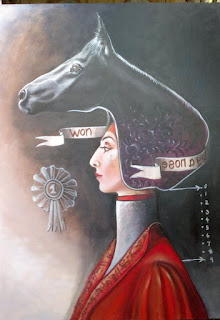Faces provide identity, display emotion, and house the
sources for the portions of our being which provide for two of the human
senses, both seeing and taste.
 |
| Faith Gerhard van Vuuren |
 |
| Thandeka Gerhard van Vuuren |
Gerhard van Vuuren began drawing and painting in elementary
school allowing him to win prizes for his art. Drawing biology sketches for
fellow students in high school gave him the opportunity to begin making money
for his incredible talent.
Being color blind has
worked as an asset when painting by removing the prescribed limits of color
which others might see. Gerhard’s unique presentation brings life to the
portraits he creates somewhat in the abstract, but at the same time being very
realistic.
 |
| Stoic Gerhard van Vuuren |
The following two paintings from his Proverbs and Idioms series invite the viewer to explore the meaning
of the portrait.
 |
| Swallows Gerhard van Vuuren |
 |
| Neck in Neck Gerhard van Vuuren |
Using mostly acrylic, Gerhard has developed various methods of
his own for creating the interesting effects we see in his portraits. Focusing primarily in female portraits, his male portraits, murals, drawings, and furniture
painting also reflect a style which is completely his own.
 |
| Contemporary Seascape Gerhard van Vuuren |
Which colors would define your portrait?
 |
| Gerhard van Vuuren Pretoria, South Africa |
Sources:






